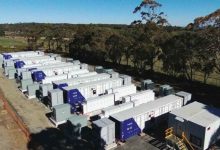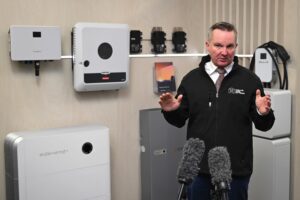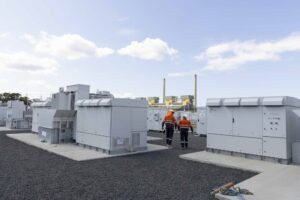Stand-alone big batteries may soon be playing a critical role in the next vital stage of Australia’s clean energy transition, becoming a viable alternative to traditional technologies for a range of much-needed upgrades to the key infrastructure that provides links between different state grids.
Big batteries have only been in Australia’s electricity market for less than three years. But already they have made their presence felt and changed the dynamics of the market, and the thinking about how the transition to a renewables-dominated grid can be put into place.
They have reduced costs and improved reliability for off-grid iron ore mines, allowed the output of wind and solar to be “stored” and “firmed”, and provided much-needed competition in the frequency and ancillary services market, played a key role in grid security, reduced costs and caused power engineers to admit there is a smarter future than relying on ageing and slow responding coal generators.
Now they are ready for the next stage – playing a critical link in providing much-needed increased capacity between the various state grids, taking advantage of their fast-response and multiple roles, and displacing more traditional choices.
That, at least, is the view of the Australian Energy Regulator, which has urged transmission companies to dig deeper into battery storage technologies as an option for the numerous grid upgrades that have recommended by the Australian Energy Market Operator to facilitate the transition to a renewables-dominated grid.
As we wrote last year, battery storage only just fell short of the usual choices when NSW-based transmission company Transgrid looked at options for the upgrade of the QNI link between NSW and Queensland that is being co-funded by the state and federal governments. See Battery storage nearly there as smarter, cheaper choice for grid upgrades
The AER has shed more light on the technology, and its possibilities, this week as it fast-tracked approval for the near term upgrade for the QNI link -, which is being rushed through to help the state deal with the anticipated closure of the Liddell coal generator in early 2023.
By that time, at least part of Australia’s biggest wind farm, the 1026MW MacIntyre wind project in Queensland, will be up and running and injecting power into the Queensland side of the interconnector.
Transgrid – the company proposing the upgrade – which is to be co-funded by the NSW and federal governments – had a look at battery storage technologies – known in the network world as “virtual transmission” – but did not consider it as one of four “credible options” because it said there was no time to do enough modelling to confirm the technologies would actually work.
The AER appeared to accept this, as it rubber stamped Transgrid’s favourite option – a mixture of “up-rating” the Liddell to Tamworth lines and installing new dynamic reactive support at Tamworth and Dumaresq and shunt capacitor banks – but is keen that the network companies put consider battery storage as a “credible option” the next time round.
Transgrid and its Queensland counterpart Powerlink had looked at a combination of 40MW/20MWh batteries and 200MW/100MWh batteries but decided that because they would be the first of its type in the country, it would need about 12 months of additional detailed network modelling and testing to ensure it was feasible.
But they were confident that batteries could play a role in the next planned upgrade, and the regulator agreed.
- “We consider that the use of grid-connected batteries, or a combination of traditional network investments and network or non-network battery solutions, are likely to be credible options or components of credible options for the medium term QNI upgrade project recommended in the draft 2020 ISP,” it notes.
It added that other batteries installed in Australia – so far there are five on the main grid at Hornsdale, Lake Bonney, Dalrymple North, Gannawarra and Ballarat – had a “proven record in delivering sophisticated network services, with resulting benefits to consumers.”
That next upgrade may not take place until around 2026, but the reality is that battery storage is likely to get its first boost in a fast-tracked proposal by the Victoria government to boost the capacity of its main link to NSW.
The Victoria state government got frustrated by the slow pace of regulatory approvals in Australia and – in quite dramatic fashion – declared that it was “going it alone” on grid upgrades, rushing new legislation through state parliament allowing it do so and commissioning AEMO to launch an EOI (expressions of interest) to facilitate a 250MW lift in capacity on the main line between Victoria and NSW.
The way that AEMO framed the EOI was thought at the time that this would favour battery storage, basically because it can allow lines to be used at their rated capacity, and deliver other important services such as SIPS (System Integrity Protection Scheme) – a quality that has been confirmed by the recent performance of the Tesla big battery at Hornsdale in South Australia.
RenewEconomy understands that AEMO received nearly 20 different proposals which were described as a “real mix”. They included big batteries and “some very innovative proposals”. AEMO will now move to a short list and issue a formal invitation to tender this month.
Battery storage maker Fluence recently compared “virtual transmission” – the use of big batteries in transmission infrastructure” – to adding lanes on a highway to ease traffic.
“The virtual transmission concept is a little-known and deceptively simple use of storage – placing energy storage on a transmission line and operating it to inject or absorb real power, mimicking transmission line flows – essentially replacing the need for a line upgrade or new line to be built,” Fluence vice president Kiran Kumaraswamy wrote in an article on RenewEconomy last year.
He said it represents a completely new way to solve congestion that can enable hundreds of megawatts of capacity to be added to lines in one-half or less deployment time compared to traditional assets.
- It’s already happening elsewhere. The German grid development plan, produced by all the transmission-owning utilities in the country, has proposed a massive 1.3 GW of energy storage to ensure grid stability and lower network costs, and in India the Andhra Pradesh Transmission Company proposed between 250 and 500 MW of energy storage to add capacity on its transmission network.
- And in the US, the PJM market – the largest power market in the world – last year received proposals for multiple 25-50 MW battery-based storage projects to help relieve network congestion issues.
- Australia’s long and skinny transmission network makes its operation more complicated, but may offer more opportunities for big batteries.
- “Unlike poles and wires, battery-based energy storage is modular and can be scaled to fit the need,” he wrote. “This is like building a side or frontage road to relieve traffic when that’s all that is needed, as opposed to wires, where the equivalent building blocks are major highways.”
- And Battery-based energy storage has response times in the millisecond range, which means that fewer megawatts will be needed to ensure balance on the network;”Deploying energy storage as a transmission resource gives Australia’s utilities an opportunity to lead the world and build a next-generation electricity network – providing new levels of network flexibility and helping ensure customers’ access to reliable, cost-effective power,” Kumaraswamy wrote.








